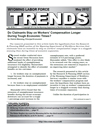
Do Claimants Stay on Workers' Compensation Longer During Tough Economic Times? (Methodology)
See related Article and Tables & Figures
Methodology
This study focuses on the types of claims for which participants in the workers’ compensation system have some degree of control. Therefore, this research specifically examines temporary partial disability and temporary total disability claims. The following types of claims (or portions of claims) were excluded from this analysis:
Medical only workers’ compensation claims. From first quarter 2004 (2004Q1) to first quarter 2012 (2012Q1), 81.6% of all workers’ compensation claims were medical only claims. These claims involve an injury from which a worker fully recovers and no disability or impairment payments are made. An example of this would be a worker who cuts his finger and requires stitches. No disability or impairment is caused and the worker resumes his or her job duties.
Fatality or permanent total disability claims. These claims are not included in this analysis as none of the participants would have any influence on the workers’ compensation claim in terms of duration, medical costs, and disability payments. Any payments made in these cases would be determined solely by workers’ compensation statutes.
The impairment compensation component of claims, such as permanent partial impairment claims. Impairment payments are made if a worker is still impaired after medical treatment and rehabilitation efforts have been exhausted. These claims were excluded because the impairment designation is not affected by any of the participants, other than the medical assessment of the impairment.
Unusual claims. Claims involving litigation or other non-standard procedures makes the calculation of actual disability duration problematic.
Also excluded from this analysis were non-regular employees (such as inmates and volunteers) and workers who had two or more claims within a quarter, because it would be difficult to separate the effects of the two injures on the duration of the claims. Claims greater 36 months in duration were also excluded because these cases are very unusual and skew the mean statistics.
After these exclusions, 18,877 claims remained in the dataset used for this analysis. These claims accounted for 86.1% of all compensation claims from 2004Q1 to 2012Q1. The most recent year and quarter of initial injury date included in the analysis was 2010Q2 in order to ensure that there were at least 24 months of possible data on any given claimant. This resulted in 15,721 observations in the dataset for analysis.
A frequency distribution of the duration of all claims used in the analysis was created. The mean and median duration of claims will also be displayed on the chart. A table and figure showing the mean and median duration of claims by the year and quarter of injury was produced.
The following means comparison tests were used: Duncan’s Multiple Range Test, Bonferroni, LSD, Student-Newman-Keuls, and Tukey. These tests all have strengths and weaknesses (SAS, 2012). Only the results of the Duncan rankings are presented in the results section of the article, as all the tests yielded similar results.
References
SAS/STAT(R) 9.2 User's Guide, Second Edition. Alternative Multiple Comparison Procedures. Retrieved May 3, 2012, from http://support.sas.com/documentation/cdl/en/statug/63033/HTML/
default/viewer.htm#statug_anova_sect027.htm
